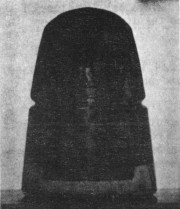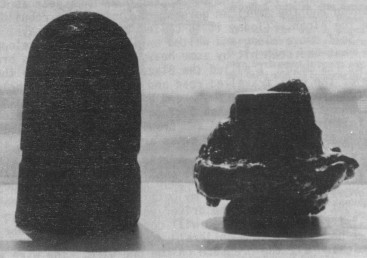"Patent Pages"
by Ray Klingensmith
Reprinted from "INSULATORS - Crown Jewels of the Wire", January 1981, page 16
The 1871 Chester "Iron Ring" Patent
It's funny how
sometimes you will have a question about something, and the answer will stare
you in the face for years without your being aware of it. Well, one of those
questions was answered awhile back. On a trip through New York last spring I
stopped to visit with the Graham Barnes family. I had a very enjoyable time and
learned a great deal from Graham about the good ole days of collecting. One very
interesting theory Graham mentioned while I was there concerned the
"Chester Boston" (see photo at left).

Tom Moulton photo
The
Insulator embossed CHESTER 104 CENTRE ST NY PATENTED. Similar in many ways to
the Boston Bottle Works embossed insulator. |
The insulator involved was
covered in the "Boston" article in the August '79 issue of Crown
Jewels. The insulator is marked on the base of the inner skirt "CHESTER 104
CENTRE ST NY PATENTED. The four segmented threads and six sided dome are similar
to those insulators marked "Boston Bottle Works", so one could assume
that Boston Bottle Works, of Somerville, Mass., made them for the Chester firm,
which was a telegraph equipment supply house in New York. We had an idea where
these were made, but I didn't know, nor had I ever heard anyone else guess why
the Chester had the "wavy" wire groove and three equally spaced slots
on the dome leading to the wire groove.
Well, that mystery seems to have been
solved by Graham. Somehow, he managed to come up with the idea that the
insulator was designed that way to accept the 1871 patented "Chester
Ring" which is shown in Figure 1 on the page following. The drawing shows
three equally spaced points which came in contact with the insulator. (See
patent specifications on the next page for a complete description and
explanation.) The idea behind this device was that it avoided contact all the
way around the insulator as would be the case with a tie wire, and therefore
avoided the higher risk of current leakage if the insulator had moisture on it.
With the Chester Ring, the only contact the insulator would have would be with
the three small points. A few similar rings, which were used with the wood
covered type insulator, have been found in Canada; but I haven't heard of any
being found with the "Boston" type Chester.
The Canadian
Chester type ring may have been an earlier type which did not have the three
points, but rather was pressed completely around the insulator. I'll find out
which types were used and report on it in the future. The "Boston"
Chesters have all (with the exception of one in St. Louis), to my knowledge,
been found on a telegraph line which followed the Ulster & Delaware Railroad
in Delaware County, New York. Ron Gavin and Kevin Lawless have probably had as
many of these over the years as anyone, and they report that of the ones found,
very few were in excellent condition.
Getting back to Graham's original idea of
the ring being used with the "Boston" type Chester, he mentioned the
reason the groove may have been "wavy" (in a slightly up and down
pattern) was that if the ring was on the insulator, and the line wire broke, the
ring would slide along the groove a short distance, and when coming to the
change in direction of the groove, the ring could no longer turn. This would be
an advantage, as it would not allow the line to drop, and it also would put less
strain on the insulator and pin, and therefore would be less apt to break. All
this is mentioned in the patent information, so I'd say Graham had a good
theory.
As mentioned earlier, a "ring" has been found with wood
covered insulators in Canada. I'd like to mention that the Chesters offered a
similar type of ring several years prior to the 1871 patent. I believe it did
not have the three points, but rather was pressed around the entire body of the
insulator. One of these insulators and rings, with partial wood covering, is
shown on the right in the photo below.

Paul Plunkett photo
The Canadian Chester
type insulator with ring still intact
on right. Complete wood covered insulator
on left.
I'll contact the Plunketts to see which type this was. I would
very much like to go into great detail about these and other Chester insulators
at this time, but since I'm in the process of gathering material for a
"Chester" article in the near future, I will go into greater detail at
that time.
Also, I recently returned from a three week research trip "back
East", where I uncovered some new facts and some "missing links"
which will be printed in the future.
Thanks to Graham Barnes, Ron Gavin, Kevin
Lawless, Tom Moulton and Paul Plunkett for their help this month. By the way, I
hope everyone notices I always list credits in alphabetical order. I don't want
anyone to feel that someone else's material was considered more important. In
this game everyone helps a great deal with any material. By the way, folks, how
about some help in the future. Do you have any photos, catalogue copies or other
information on any insulators of interest? If so, please contact me at 709 Rt.
322, East Orwell, OH 44034. Thanks.
| 